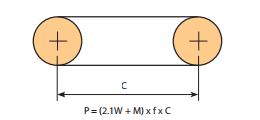Introduction
A mindful evaluation on the situations surrounding a conveyor is important for correct conveyor chain variety. This part discusses the fundamental concerns essential for profitable conveyor chain selection. Roller Chains are sometimes applied for light to reasonable duty material managing applications. Environmental situations may perhaps need the usage of particular resources, platings coatings, lubricants or even the means to operate without having further external lubrication.
Standard Facts Essential For Chain Selection
? Type of chain conveyor (unit or bulk) like the process of conveyance (attachments, buckets, via rods and so on).
? Conveyor layout like sprocket places, inclines (if any) as well as number of chain strands (N) to be used.
? Amount of material (M in lbs/ft or kN/m) and variety of materials to get conveyed.
? Estimated excess weight of conveyor parts (W in lbs/ft or kN/m) which include chain, slats or attachments (if any).
? Linear chain speed (S in ft/min or m/min).
? Environment in which the chain will operate including temperature, corrosion circumstance, lubrication ailment and so on.
Phase one: Estimate Chain Tension
Utilize the formula below to estimate the conveyor Pull (Pest) and after that the chain stress (Test). Pest = (M + W) x f x SF and
Test = Pest / N
f = Coefficient of Friction
SF = Pace Component
Step two: Create a Tentative Chain Selection
Employing the Check value, produce a tentative selection by deciding upon a chain
whose rated doing work load higher compared to the calculated Test value.These values are suitable for conveyor service and therefore are diff erent from those proven in tables in the front in the catalog that are linked to slow speed drive chain utilization.
Furthermore to suffi cient  load carrying capability often these chains needs to be of the specified pitch to accommodate a desired attachment spacing. By way of example if slats are for being bolted to an attachment just about every one.5 inches, the pitch in the chain chosen need to divide into 1.5?¡À. So one could use a 40 chain (1/2?¡À pitch) together with the attachments every 3rd, a 60 chain (3/4?¡À pitch) with the attachments each 2nd, a 120 chain (1-1/2?¡À pitch) using the attachments each and every pitch or perhaps a C2060H chain (1-1/2?¡À pitch) together with the attachments every pitch.
load carrying capability often these chains needs to be of the specified pitch to accommodate a desired attachment spacing. By way of example if slats are for being bolted to an attachment just about every one.5 inches, the pitch in the chain chosen need to divide into 1.5?¡À. So one could use a 40 chain (1/2?¡À pitch) together with the attachments every 3rd, a 60 chain (3/4?¡À pitch) with the attachments each 2nd, a 120 chain (1-1/2?¡À pitch) using the attachments each and every pitch or perhaps a C2060H chain (1-1/2?¡À pitch) together with the attachments every pitch.
Phase three: Finalize Choice – Calculate Real Conveyor Pull
Following creating a tentative variety we have to verify it by calculating
the actual chain stress (T). To carry out this we need to fi rst determine the real conveyor pull (P). In the layouts proven within the ideal side of this page opt for the suitable formula and calculate the total conveyor pull. Note that some conveyors can be a mixture of horizontal, inclined and vertical . . . in that situation calculate the conveyor Pull at every single part and include them collectively.
Step four: Determine Highest Chain Stress
The maximum Chain Tension (T) equals the Conveyor Pull (P) as calculated in Phase three divided from the variety of strands carrying the load (N), instances the Speed Component (SF) proven in Table 2, the Multi-Strand Element (MSF) shown in Table three and also the Temperature Aspect (TF) proven in Table four.
T = (P / N) x MSF x SF x TF
Stage 5: Check out the ?¡ãRated Operating Load?¡À on the Chosen Chain
The ?¡ãRated Doing work Load?¡À in the picked chain should really be higher than the Greatest Chain Stress (T) calculated in Stage four over. These values are proper for conveyor services and are diff erent from these proven in tables with the front from the catalog that are related to slow velocity drive chain usage.
Stage six: Examine the ?¡ãAllowable Roller Load?¡À in the Chosen Chain
For chains that roll to the chain rollers or on top rated roller attachments it is needed to check the Allowable Roller Load?¡À.
Note: the Roller load is determined by:
Roller Load = Wr / Nr
Wr = The total excess weight carried from the rollers
Nr = The amount of rollers supporting the weight.
